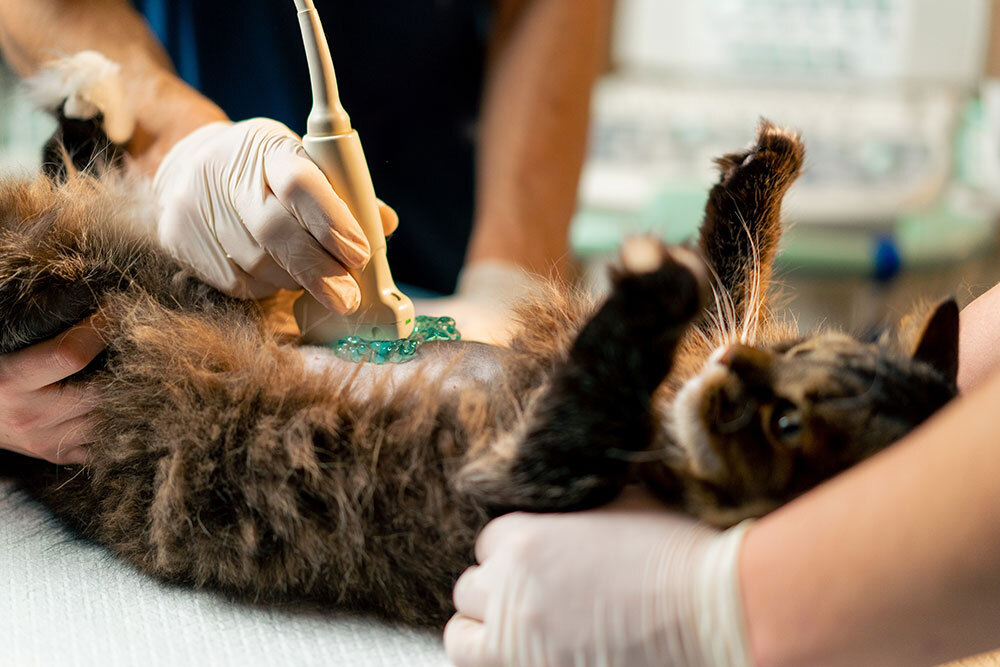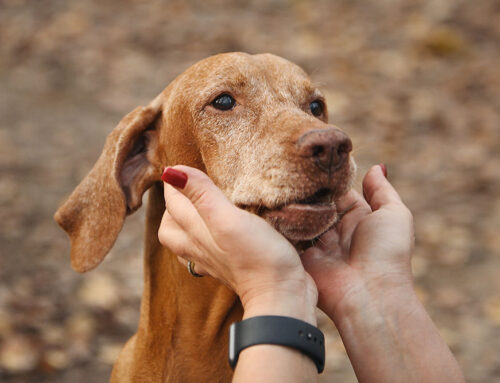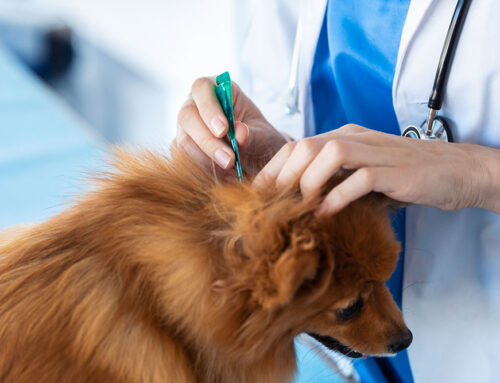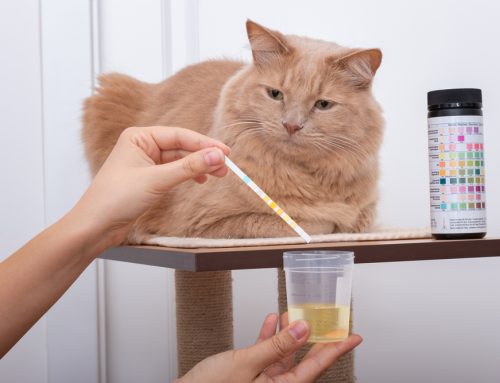Pyometra in Dogs and Cats: A Silent Emergency Every Pet Owner Should Know About
A dog that seems unusually tired. A cat that suddenly refuses meals and hides under the bed. An unspayed female pet with a distended abdomen or unexpected vaginal discharge. These situations might look like minor illness at first glance, but they can point to one of the most dangerous reproductive conditions veterinarians treat: pyometra.
At Midtown Veterinary Hospital, we see how quickly pyometra can progress from vague signs to a true crisis. Because we are AAHA-accredited, we follow the highest standards in emergency care, diagnostics, and surgery, ensuring pets get the best chance at recovery. Recognizing how pyometra forms, the signs it causes, and the urgency of surgical treatment is essential for keeping your pet safe.
How Pyometra Develops and the Forms It Can Take
Pyometra is a bacterial infection of the uterus. It develops in unspayed dogs and cats, most often after repeated heat cycles. Hormonal changes make the uterine lining thick and vulnerable to infection, allowing bacteria to thrive.
There are two main forms:
- Open pyometra: The cervix is open, and pus drains through the vagina. Owners may notice discharge, often foul-smelling. While this may seem alarming, it signals that some infection is leaving the body. However, an open pyometra can close at any time, trapping infection inside.
- Closed pyometra: The cervix remains shut, keeping pus and bacteria sealed in the uterus. This is especially dangerous, as toxins build silently and signs are often vague until the pet becomes critically ill.
Both types require urgent veterinary intervention.
Cats are at risk as well, though pyometra in cats is somewhat less common. Because cats often hide illness, their infections may not be discovered until the disease is severe.
In rare cases, a complication called stump pyometra can occur in spayed pets if a small piece of uterine or ovarian tissue remains after surgery. That tissue still responds to hormones, and infection can develop. Stump pyometra looks and acts much like a traditional pyometra and requires surgical removal of the infected tissue.
Spotting the Early Warning Signs
Pyometra can be deceptive because it does not always cause dramatic illness in the beginning. Instead, owners may notice subtle changes such as:
- Fever, trembling, or shivering
- Enlarged or painful abdomen
- Vaginal discharge in cases of open pyometra
- Lethargy or weakness
- Reduced or absent appetite
- Increased thirst and urination, especially in dogs
- Vomiting or diarrhea
Cats may show quieter signs such as hiding, decreased grooming, or general discomfort.
Importantly, stump pyometra can mimic these symptoms even in spayed pets. Any female pet showing these red flags, whether intact or previously spayed, needs veterinary attention right away.
Why Pyometra Requires Immediate Care
Pyometra is a true medical emergency. The infection spreads quickly, and within days can cause:
- Septicemia: bacteria and toxins flooding the bloodstream
- Kidney failure: toxins overwhelming the kidneys’ ability to filter
- Uterine rupture: pus spilling into the abdominal cavity
- Multi-organ failure: body systems shutting down without intervention
AAHA emphasizes that pyometra is not a condition to monitor at home. Pets can go from “not quite right” to critically ill in hours. Stump pyometra carries the same risks, since infected tissue can rupture or spread toxins just as aggressively.
Why Antibiotics Are Not Enough
Families sometimes wonder if antibiotics alone could treat pyometra. Unfortunately, medication cannot cure the disease.
- In open pyometra, antibiotics may reduce bacteria temporarily, but infection will always return.
- In closed pyometra, antibiotics cannot penetrate the sealed uterus, leaving the infection untouched.
- In stump pyometra, antibiotics may mask symptoms briefly, but infected tissue remains until surgically removed.
The only definitive treatment is emergency surgery to remove the infected uterus and ovaries.
The Role of Surgery and Supportive Care
Surgery for pyometra, called an ovariohysterectomy, is similar in principle to a spay but far more complicated. The uterus is distended, fragile, and infected, and the patient may already be unstable. At Midtown Veterinary Hospital, our surgery team and diagnostic capabilities work together to stabilize pets before, during, and after the procedure.
Successful treatment often involves:
- Bloodwork to assess organ function and detect complications
- IV fluids to maintain hydration and blood pressure
- Antibiotics to control infection
- Pain relief and intensive monitoring
Our AAHA-accredited standards ensure that every patient undergoing pyometra surgery receives advanced monitoring and comprehensive care throughout recovery.
The Consequences of Delaying Surgery
Every hour counts when it comes to pyometra. Postponing surgery, even briefly, increases the likelihood of serious complications:
- In cases of closed pyometra, the swollen uterus can rupture, spilling infection into the abdomen.
- The buildup of toxins can overwhelm the kidneys, leading to organ failure.
- Infection in the bloodstream may progress to septic shock, a condition that can quickly become fatal.
While antibiotics might create the illusion of improvement, the infection never truly goes away and often returns more aggressively. Surgical removal of the infected tissue is the only treatment that ensures recovery and prevents recurrence.
Spaying as Prevention
The most effective way to prevent pyometra is through timely spaying. Removing the uterus and ovaries eliminates the risk entirely. Additional benefits include:
- Prevention of ovarian cancer
- Dramatic reduction in risk of mammary cancer
- Increased lifespan, as supported by the ASPCA
Our reproductive health services allow families to discuss the best spay timing for their pet’s breed, age, and health status. Careful surgical technique also helps prevent the rare complication of stump pyometra.
Life After Pyometra Surgery
Recovery from pyometra surgery is more intensive than a routine spay. Pets need strict rest, close monitoring, and follow-up care.
- Use of an Elizabethan collar is essential to protect the incision. We know that using a cone is often a pain for everyone- here are some tips for comfort.
- Regular rechecks confirm healing is on track.
- With attentive aftercare, most pets return to full health within weeks.
When to Seek Veterinary Help
Call your veterinarian immediately if your unspayed female dog or cat shows:
- Abdominal swelling
- Vaginal discharge after a heat cycle
- Lethargy, fever, or loss of appetite
- Vomiting or excessive thirst/urination
Even if your pet is spayed, similar symptoms could indicate stump pyometra. Always err on the side of caution.
Midtown Veterinary Hospital provides emergency care during open hours and connects families with VetTriage for urgent after-hours concerns. Quick intervention can save your pet’s life.
Acting Quickly Saves Lives
Pyometra is a devastating disease because it is both common and preventable. Surgery is the only cure, and waiting can mean the difference between life and death. With fast recognition, advanced diagnostics, and skilled surgical care, most dogs and cats recover fully.
At Midtown Veterinary Hospital, we are dedicated to protecting pets through wellness and prevention, reproductive health counseling, and emergency surgery when needed. If you suspect your pet could be suffering from pyometra, don’t delay. Call us right away at (585) 546-1550 for immediate guidance.







Leave A Comment